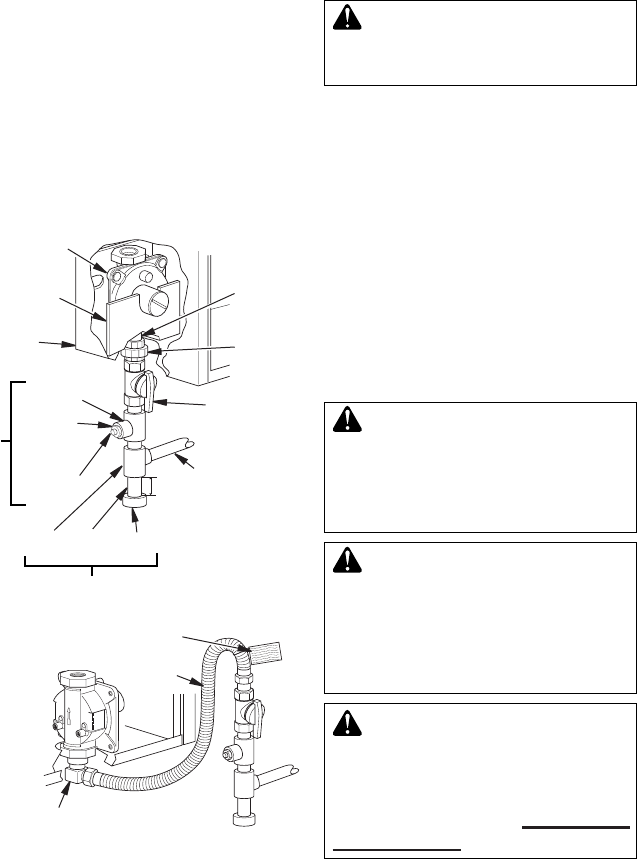
www.fmiproducts.com
125311-01A12
CHECKING GAS CONNECTIONS
WARNING: Test all gas piping
and connections, internal and
external to unit, for leaks after
installing or servicing. Correct
all leaks at once.
WARNING: Never use an
open ame to check for a leak.
Apply a noncorrosive leak detec-
tion uid to all joints. Bubbles
forming show a leak. Correct all
leaks at once.
CAUTION: For propane/LP
units, make sure external regula-
tor has been installed between
propane/LP supply and heater.
See guidelines under Connecting
to Gas Supply, page 11.
PRESSURE TESTING GAS SUPPLY
PIPING SYSTEM
Test Pressures In Excess Of 1/2 PSIG (3.5 kPa)
1. Disconnect appliance with its appliance
main gas valve (control valve) and equip-
ment shutoff valve from gas supply piping.
Pressures in excess of 1/2 psig will dam-
age heater regulator.
INSTALLATION
Continued
Figure 15 - Gas Connection
IMPORTANT: Install an equipment shutoff
valve in an accessible location. The equip-
ment shutoff valve is for turning on or shutting
off the gas to the appliance.
Check your building codes for an special
requirements for locating equipment shutoff
valve to heater.
Apply pipe joint sealant lightly to male NPT
threads. This will prevent excess sealant from
going into pipe. Excess sealant in pipe could
result in clogged heater valves.
Tee Pipe Cap
J oint Nipple
Tee Joint
Reducer
Bushing to
1/8" NPT
1/8" NPT
Plug Tap
Pressure
Regulator
Test Gauge Connection*
Heater
Cabinet
Sediment Trap
3"
Min.
Natural Gas
From Gas
Meter (7" W.C.
to 10.5" W.C.
Pressure)
Propane/LP
From External
Regulator
(11" W.C. to 14"
W.C. Pressure)
Regulator
Bracket
Ground
Joint
Union
3/8" NPT
Pipe
Nipple
Equipment
Shutoff
Valve*
Connection Using Flexline
3/8" NPT/ 1/2"
Flare 90° Elbow
Flexline
See
illustration
above for
detail
Refer to connector's
instructions
* An equipment shutoff valve with 1/8" NPT
tap is an acceptable alternative to test gauge
connection. Purchase the optional equipment
shutoff valve from your dealer.
WARNING: Use pipe joint
sealant that is resistant to liquid
petroleum (LP) gas.
Install sediment trap in supply line as shown
in Figure 15. Locate sediment trap where it
is within reach for cleaning. Locate sediment
trap where trapped matter is not likely to
freeze. A sediment trap traps moisture and
contaminants. This keeps them from going
into heater controls. If sediment trap is not
installed or is installed wrong, heater may
not run properly.
IMPORTANT: Hold the pressure regulator with
wrench when connecting it to gas piping
and/or ttings. Do not over tighten pipe con-
nection to regulator. The regulator body could
be damaged.


















